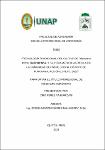| dc.contributor.advisor | Flores Malaverry, Jorge Agustín | |
| dc.contributor.author | Perez Yahuarcani, Ciro | |
| dc.date.accessioned | 2023-09-27T18:50:03Z | |
| dc.date.available | 2023-09-27T18:50:03Z | |
| dc.date.issued | 2023 | |
| dc.identifier.other | 631.526 P45 2023 | |
| dc.identifier.uri | https://hdl.handle.net/20.500.12737/9361 | |
| dc.description.abstract | The present work deals with the traditional technology of the cultivation of Dioscorea trifida -sachapapa- and its agricultural permanence in the community of Padre Cocha, district of Punchana, Loreto region, during the year 2022. It proposes to describe traditional technological characteristics of the cultivation of Dioscorea trifida (sachapapa), and determine the time of use of the sachapapa crop in the "chacras" and the resting age of the "purmas", in the community of Padre Cocha. It is a descriptive, correlational and transversal work. 40 surveys were applied to producers of this crop at the study site. Descriptive statistics were applied to the results obtained and are presented below: the technology used for the persistence of this crop is traditional, they use the seed from their previous harvests and sow it in established crop sites in almost free areas. without shadows, they dig a 10-centimeter hole in the ground and fill it with organic material and deposit the seeds, over the course of two months they consider putting a tutor to the plant because of its creeping habit, they always keep weeded the places where the plants were planted strains to avoid pests and diseases, they harvest in times of 12 to 14 months, observing how the plant turns yellowish and dries up. They do not plant in large areas, but what they harvest generates some economic income. They are familiar with four varieties, but choose to plant the white and purple variety because of its commercial advantages. They prepare their soils in the traditional way and many times they let them rest for 3 to 4 years, before opening a new farm, with the help of family labor. It keeps it seeds in the harvest field itself, burying them or watering them on the ground to remove the harvest soil and lower the humidity. The producers have lived in that area for more than 41 years and private land ownership prevails. | en_US |
| dc.description.abstract | El presente trabajo, versa sobre la tecnología tradicional del cultivo de Dioscorea trifida -sachapapa- y su permanencia agrícola en la comunidad de Padre cocha, distrito de Punchana, región Loreto, durante el año 2022. Plantea describir características tecnológicas tradicionales del cultivo de Dioscorea trífida (sachapapa), y determinar el tiempo de uso del cultivo de sachapapa en las “chacras” y la edad de reposo de las “purmas”, en la comunidad de Padre Cocha. Es un trabajo descriptivo, correlacional y transversal. Se aplicaron 40 encuestas a productores de este cultivo en el sitio de estudio. A los resultados emanados, se les aplicó la estadística descriptiva y se presentan a continuación: la tecnología usada para la persistencia de este cultivo es tradicional, utilizan la semilla de sus cosechas anteriores y siembran la misma en sitios de cultivos establecidos en las áreas libres casi sin sombras, excavan un hoyo de 10 centímetros en el suelo y lo rellenan con material orgánico y depositan las semillas, en el transcurso de dos meses consideran poner un tutor a la planta por su hábito rastrero, conservan siempre desmalezado los lugares donde se sembraron las cepas para evitar plagas y enfermedades, cosechan en tiempos de 12 a 14 meses, observando la planta como se vuelve amarillenta y se seca. No siembran en áreas extensas, pero lo que cosechan les genera ciertos ingresos económicos, Conocen cuatro variedades, pero optan por sembrar la variedad blanca y morada por tener ventajas comerciales. Preparan sus suelos de la manera tradicional y muchas veces dejan descansar de 3 a 4 años, para luego abrir una nueva chacra, con ayuda de mano de obra familiar. Conserva sus semillas en el propio campo de cosecha, enterrando los mismos o regados sobre el suelo para quitar la tierra de cosecha y bajar la humedad, Los productores moran en esa zona por mas de 41 años y prevalece la tenencia de tierras privada. | es_PE |
| dc.format | application/pdf | es_PE |
| dc.language.iso | spa | es_PE |
| dc.publisher | Universidad Nacional de la Amazonía Peruana | es_PE |
| dc.rights | info:eu-repo/semantics/openAccess | * |
| dc.rights.uri | https://creativecommons.org/licenses/by/4.0/ | * |
| dc.subject | Plantas de raíces comestibles | es_PE |
| dc.subject | Cultivos | es_PE |
| dc.subject | Tecnología tradicional | es_PE |
| dc.subject | Condiciones culturales | es_PE |
| dc.subject | Sachapapa | es_PE |
| dc.subject | Dioscorea trifida | es_PE |
| dc.title | Tecnología tradicional del cultivo de Dioscorea trifida -sachapapa- y su permanencia agrícola en la comunidad de Padre Cocha, distrito de Punchana, región Loreto. 2022 | es_PE |
| dc.type | info:eu-repo/semantics/bachelorThesis | es_PE |
| thesis.degree.discipline | Agronomía | es_PE |
| thesis.degree.grantor | Universidad Nacional de la Amazonía Peruana. Facultad de Agronomía | es_PE |
| thesis.degree.name | Ingeniero(a) Agrónomo | es_PE |
| dc.subject.ocde | https://purl.org/pe-repo/ocde/ford#4.01.06 | es_PE |
| renati.author.dni | 62476460 | |
| renati.advisor.orcid | https://orcid.org/0000-0002-1125-8600 | |
| renati.advisor.dni | 05203391 | |
| renati.type | https://purl.org/pe-repo/renati/type#tesis | es_PE |
| renati.discipline | 811036 | es_PE |
| renati.level | https://purl.org/pe-repo/renati/level#tituloProfesional | es_PE |
| renati.juror | Yalta Vega, Ronald | |
| renati.juror | Chavez Vasquez, Rafael | |
| renati.juror | Pinedo Jimenez, Julio | |
| dc.publisher.country | PE | es_PE |





